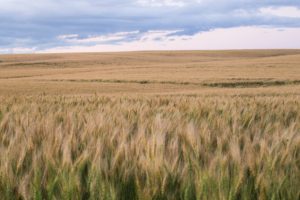
When Christians today think of Pentecost, they generally don’t relate it to the Jewish holidays or the Old Testament at all, or if they do, primarily as a date for a harvest celebration. Naturally, they think of the Book of Acts and the birth of the Church in its formative years. But as a result, they miss the remarkable and grander meaning of the fourth and central feast among the seven Feasts of Israel, and which undeniably points to the Church and the conclusion of the Church age.
On that first Easter Sunday, the resurrection of Jesus Christ occurred on the Feast of Firstfruits, and that same morning at the Jerusalem Temple the high priest would customarily wave a sheaf of grain before the Lord to commemorate the first fruits of the coming harvest. The sheaf was known as an “omer” and was generally a bundle of young barley, some of it may have been slightly green. It was like a sample harvest of what is to come 50 days later at the mid-summer full harvest known as “Pentecost.” Thus, began the “counting of the omer” until the day of Pentecost.
He referred to Himself as the “bread of life” and just prior to His crucifixion Jesus said, “Verily, verily, I say unto you, Except a corn of wheat fall into the ground and die, it abideth alone: but if it die, it bringeth forth much fruit.” (John 12:24) Just as the high priest waved a sample of the harvest to come, having been buried for three days Jesus likened His resurrection to that sheaf of barley as a representation of a promised greater harvest to come. The Bible tells us that Jesus is the “first fruits of the resurrection” in 1st Corinthians 15:23. Likewise, Jesus is the guaranty of a harvest to come, the full harvest at the end of the Church age.
As the Dallas Theological Seminary describes it, the Firstfruits offering was like “a preliminary installment” of the final harvest to come much later. Who or what is “much fruit?” It is the Church.
Just as the high priest would not hold up just a single stem, he was instructed from Leviticus 23 to hold up a bundle to denote a sample of the harvest to come. Likewise, Jesus was resurrected and appeared to many, but also the Bible tells us, “And the graves were opened; and many bodies of the saints which slept arose, And came out of the graves after his resurrection, and went into the holy city, and appeared unto many.” (Matthew 27:52-53). At His resurrection, Jesus was then accompanied by a large number of Old Testament saints who had waited for His coming and they were emptied from the upper chamber of Hades, otherwise known as “Abraham’s bosom.” Paul tells us in 1st Corinthians 15:20 that Christ is “the firstfruits of them that slept.”
Beginning on Firstfruits, the high priest would begin the “counting of the omer” for the next 49 days waving a new sheaf offering each day. This countdown would culminate after 50 days in the celebration of Pentecost or what the Jews call “Shavuot” which means “weeks.” Originally, it was known in the Old Testament as the “harvest of firstfruits” and then later became known as the “feast of weeks.”
The Greek word is “pentekoste” which means “50 or fiftieth” but is also used symbolically as a “fulness or completion.” Fifty is also the number of Jubilee in the Sabbatical/Jubilee system of years.
Ever since the Exodus, on the morning of Pentecost the Jewish high priest, according to Leviticus 23:17, would come out and wave two loaves of bread, “they shall be of fine flour….they shall be baked with leaven…they are the firstfruits unto the Lord.” It was a celebration and an offering of thanksgiving to the Lord for the final and full harvest (Leviticus 7:13). Yet no one seems to know precisely why “two” loaves are waved and why they are baked with leaven, which is always denoted as a symbol of sin elsewhere in the Bible. Some have suggested the loaves are representative of a “double blessing” on all who call Christ their Savior. Others say it may symbolize Christ the Bridegroom and His Bride, the Church. Others (including myself) interpret the two loaves to denote the two houses seen in Revelation, the Church and spiritual Israel, that will live together for eternity.
“For we being many are one bread, and one body: for we are all partakers of that one bread.” (1st Corinthians 10:17)
It was about the same time that these two loaves were being waved by the high priest, it coincided with Acts 2 that a strong and loud wind swept through Jerusalem early one morning in the Temple area. “And when the day of Pentecost was fully come, they were all with one accord in one place. And suddenly there came a sound from heaven as of a rushing mighty wind, and it filled all the house where they were sitting. And there appeared unto them cloven tongues like as of fire, and it sat upon each of them. And they were filled with the Holy Ghost, and began to speak with other tongues, as the Spirit gave them utterance.” (Acts 2:1-4) The disciples had been praying through the night “in one accord” and “fully come” means early morning.
Although often overlooked, the Church has a vital connection to this Feast of Pentecost, and it is a type* in so many ways of the Rapture of the Church. In one moment a couple of hundred Jews were praying, in the next instant the Church of Jesus Christ was born and the Holy Spirit of God took residence in the hearts and minds of believers. In this same manner, the Church will be raptured when the time of the final harvest has come. But, this is not to predict or proclaim that the Rapture of the Church will occur on the day of Pentecost, for no one knows and it cannot be predicted. “But of that day and hour no one knows, not even the angels of heaven, nor the Son, but the Father alone.” (Matthew 24:36)
As earlier mentioned, “pentekoste” means “50 or fiftieth” but also denotes symbolically a “fulness or completion.” When putting the full harvest of the Church in prophetic perspective, one cannot but recall Paul’s words as to when the Church age would end. “For I would not, brethren, that ye should be ignorant of this mystery, lest ye should be wise in your conceits; that blindness in part is happened to Israel, until the fulness of the Gentiles be come in.” (Romans 11:25) In this verse also, we are reminded that the Church age is a planned but temporary interruption in Daniel’s “70 weeks of years” for Israel and that James also references as the “calling out of the Gentiles” that will be followed by the rebuilding of the tabernacle of David. (Acts 15:14-17)
Pentecost is beautifully packed with incredible Biblical truths and prophetic overtones that speak to the Church, there are so many more aspects of this Feast date that remain to be shared. Why do some Jews stay up all night before Pentecost (Shavuot) to celebrate the “decorating of the bride?” What other major event occurred on this day in the Hebrew calendar? Why do so many observant Jews in Israel read the Book of Ruth the night before Pentecost? Next week.
“Ask the Lord of the harvest, therefore, to send out workers into his harvest field.” (Matthew 9:38)
*Bible typology is a form of hermeneutic and a method of Biblical interpretation whereby an element found in the Old Testament is seen to prefigure one found in the New Testament. The initial one is called the type and the fulfillment is designated the antitype. Either type can be a person, thing, or event, and is often messianic or related to salvation.


